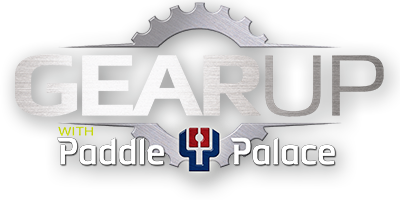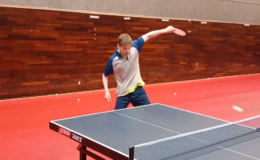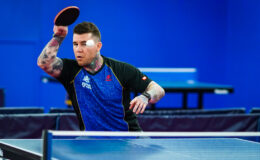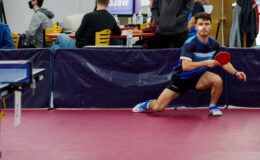
LILLIEROOS INSTITUE OF TABLE TENNIS (LITT)
A) TIMING
Timing is basic for all athletes that is a separate component that is more important than technique. If correct timing is learned first, the techniques learned become much easier. It is defined as:
1) where does all strokes start from
2) When and How to leave that starting position
3) How to change direction of your strokes and going forward
1) Where do all strokes start from?
a) Racket Neutral Position
The basic starting or ready position for your racket for all strokes is called the “Racket Neutral Position”. This position needs to accommodate Backhand and Forehand, fast and slow strokes, backspin and topspin, short and long balls. Your racket Neutral position is not favoring any strokes; it is equally ready for all strokes.
i) The racket should be aligned with the playing hand shoulder, which is in the middle of your reach. Right handed players should have their racket under their right shoulder; left handed player should have their racket under their left shoulder.
ii) The angle of the racket needs to be exactly 90 degrees in reference to the table, so as not to favor topspin or backspin in your forehand or backhand. The angle needs to be neutral.
iii) The height of the racket in the starting position needs to be above the table. When you play close to the table there is no reason to have the racket below the table.
b) Body Neutral Position
i) The centre of your body is your playing hand shoulder. The position of your playing hand shoulder needs to be in the middle of all the angles the opponent can hit the ball. This is determined by where the opponent will serve from or later in points where you hit the ball on the opponent side of the table. Your placement of your balls will determine which angles the opponent can hit the ball back to you. Example: if you hit the ball wide to the opponent’s forehand side, this will create more possible angles to hit to your forehand side (If you both are right handed players) and less angles to your backhand side. If you hit the ball wide to the opponents backhand side you create more possible angles for the opponent to hit to your backhand side and less to your forehand side.
ii) You need to adjust you racket neutral body position according to where you place the ball on the opponent side of the table. If you place the ball or if your opponent serves from the middle of the table, you need to position your playing shoulder in the middle of the table. If you hit your ball wide to the opponents Forehand corner you need to move your body neutral position more towards your forehand corner. If you hit your ball to the backhand corner you need to move your body neutral position more towards the backhand corner.
iii) The ranges of movements of the body neutral position are about 25% of the table in either direction from the middle of the table. This range makes you be able to play 50% of the table forehand and back hand. Of course some players want to favor backhand or forehand, because they have specific strengths, then they will alter this in favor of their strength.
2) When and How to leave that starting (Neutral) position
This second principle of Timing is a life time process for a player and maybe the most difficult to master, but therefore maybe the most important principle for successful table tennis athletes.
i) When the ball leaves the racket of the opponent the first movement you make is to move the body in the direction of the where your opponent will hit the ball. At that moment you will know approximately where the ball will bounce, but not exactly and your body should move in that direction. When you do that movement your racket is still in the neutral position.
ii) The moment to move the racket from the neutral position, when you play close to the table is when the ball from the opponent passes the net. When you play away from the table you need to start the movement of your racket later and basically that is when the ball bounces at your side of the table, but the movement of your body start at the same time.
iii) How you move your racket in your backswing, is at the same speed and the direction of the bounce of the ball coming to you, no matter if you goal is to hit the ball hard or soft. That sets you racket movement up for the correct acceleration at the correct time.
iv) The angle of your racket will change in your back swing. If you goal is to hit a topspin or offensive stroke you will close your angle slightly. The correct angle of your racket is a 90 degree angle between the table and your racket in reference to the ball bouncing and coming into your racket. If you goal is to make a backspin stroke you will open your angle when you leave the racket neutral position in your back swing.
v) It is very important to move your racket in the direction of the bounce of the opponent’s ball and the goal is to have your racket behind the ball most of the time.
3) How to change direction of your strokes and going forward
The move forward is divided in three parts.
i) The acceleration phase
ii) The contact phase
iii) The follow through after the contact
i) The moments when you change direction of you stroke is where you determine the speed of you stroke. The best acceleration (if you are in balance) is done with your core that follows with your playing arm. If you desire a hard stroke (both backhand and forehand) you accelerate fast with your core (If the player has a physically functional core), which follows with a relaxed arm and wrist. If you desire a slower stroke the acceleration is slower.
ii) The contact phase. Research with high speed cameras has shown us that the ball stays on the racket from 1-3 1000’s of a second. This means that once the ball contacts the racket we cannot change anything while the ball is on the racket. Therefore the angle we use before and after the contact needs to be the same as our desired contact angle, as not to take any chances with such a short contact time. Even a millimeter in change of angle can generate an error in the stroke in table tennis.
iii) The follow through after the contact
The fastest recovery time for the next stroke is to end your stroke in the racket neutral position. This is desirable if you hit the ball with the same speed as your opponent or slower. If your goal is to hit the ball faster than the opponent, and you want to generate maximum power, you should end your stroke passed the racket neutral position in a relaxed manner. To artificially stop your stroke in the racket neutral position will create a tight stroke, and will create an unnatural flow in your stroke, and can result in more errors, and less power and touch or control. A relaxed follow through with your arm is very essential for good control of you strokes.




